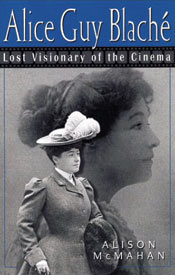(Continuum, 384 pages, $19.95)
By Alison McMahan

An article in Photoplay magazine once described Alice Guy Blache as "a striking example of the modern woman in business who is ... succeeding in a line of work in which hundreds of men have failed."
When that was written in 1912, Alice Guy BlacheThe Film Encyclopedia by Ephraim Katz lists her as "The world's first woman director and possibly the first director of either sex to bring a story-film to the screen." Many feminist film historians would take "possibly" out of the discussion, naming her the world's first story-film director; period. But in Alice Guy Blache, intrepid author Alison McMahan honors her readers by offering a more nuanced, in-depth and ultimately enlightening approach. "[D]id Alice Guy direct the first fiction-film? The answer is not a simple yes or no.
McMahan's book, originally published in 2002 and available now in paperback, was 10 years in the making and began life as a doctoral thesis. It has the impressive scholarship and authoritative documentation that its subjects deserve. Yes, subjects, plural. For this is not only what must surely be the definitive biography of Guy (as she is called here), both person and filmmaker, it is also a valuable window into the evolution of film itself.
A little perspective: December 28, 1895 (the first time Louis and Auguste Lumiere showed their non-story films in Paris to a paying public), is generally accepted as the birthday of world cinema. Guy wrote, produced and directed her first film, La Fee aux Choux (The Cabbage Fairy), "before May of 1896."
But McMahan, who includes liberal selections from Guy's own memoirs, is not obsessed with who's on first. She is more interested in exploring what Alice Guy's overall contributions were and what Guy might have to say to today's filmgoers and filmmakers. "Was she a feminist? Can she, in fact, serve as a guide for feminist filmmakers?"
Alice Guy directed about a thousand films (and produced even more); only 111 survived. McMahan doggedly traced as many of these survivors as possible; no easy feat as Guy's films are "spread out in archives all over the world," and often unavailable for viewing "even to scholars" and many are in desperate need of restoration. McMahan brings the fruits of her labors to us, scrutinizing the films here for their content as well as production.
Guy's career is fascinating on several levels. She was a pioneer in sound, directing more than 100 synchronized sound films between 1902 and 1906; something, McMahan points out, that "is almost never mentioned." The French woman owned and ran her own studio, Solax, in Fort Lee, New Jersey, when, in 1912, it produced two one reelers (10-15 minute films) a week. Guy wrote and directed "at least half of these" and oversaw all production; a rate that equaled "that of D.W. Griffith, working at Biograph just a few miles away." (Guy also shot close-ups before Griffith did.)
McMahan supplies copious rare photographs and remarkable data, from a convenient timeline and multiple filmographies to appendices that include listings of extant films and where to find them. Through McMahan's astute descriptions of the films, we come away amazed at Guy's perspicacity and artistic imagination. Her 1906 film, La Passion ou la Vie de Notre Seigneur Jesus Christ (The Passion or the Life of Our Lord Jesus Christ), "differs in many significant ways from the established genre of passion plays," particularly in its focus on the roles of women.
Guy's last film, Tarnished Reputations, was released in 1920 when she was 47.
When she died in 1968 at 95, "there was no obituary," McMahan writes, "and no indication on her tombstone that she was the first woman filmmaker and the only woman filmmaker for the first decade of the industry's history." McMahan, through these pages, makes amends for decades of neglect.
Review written by Lisa Mitchell